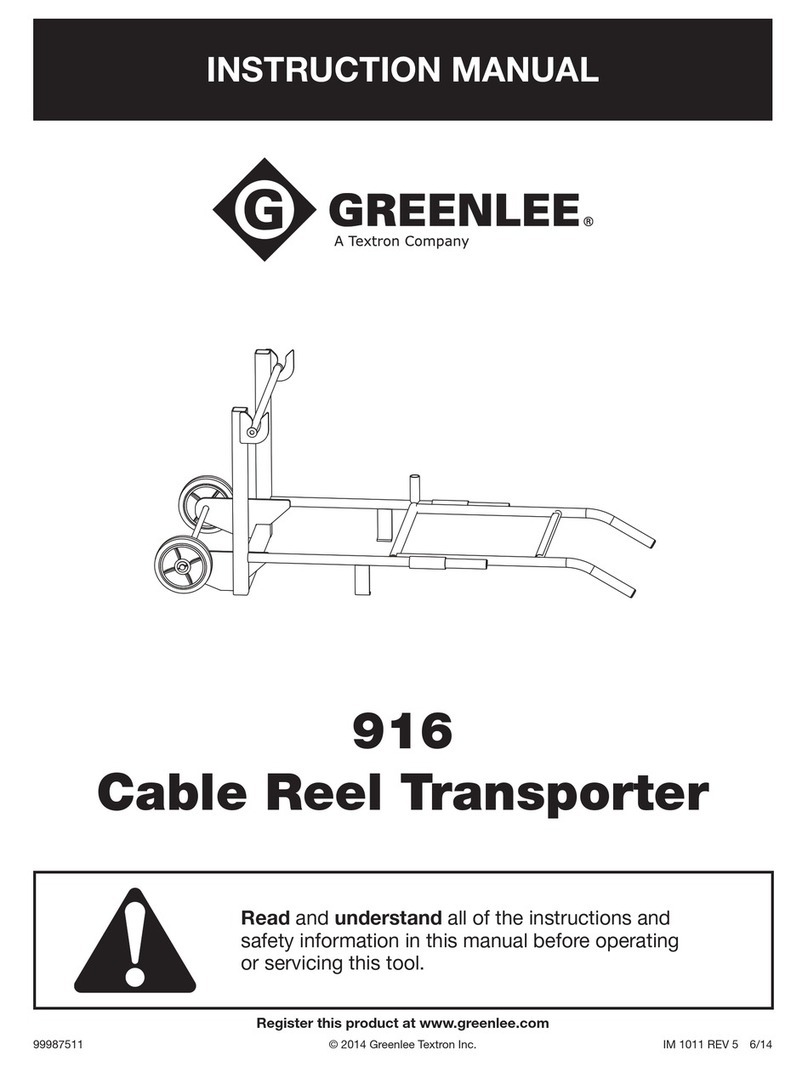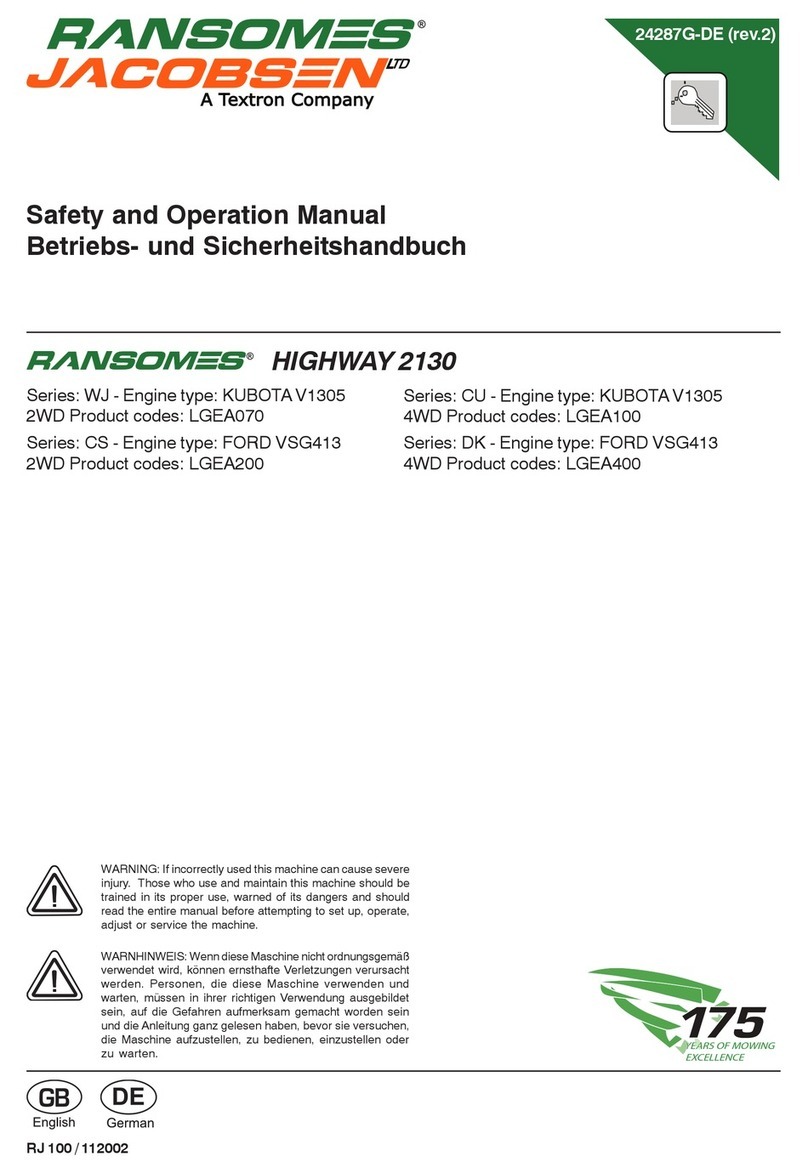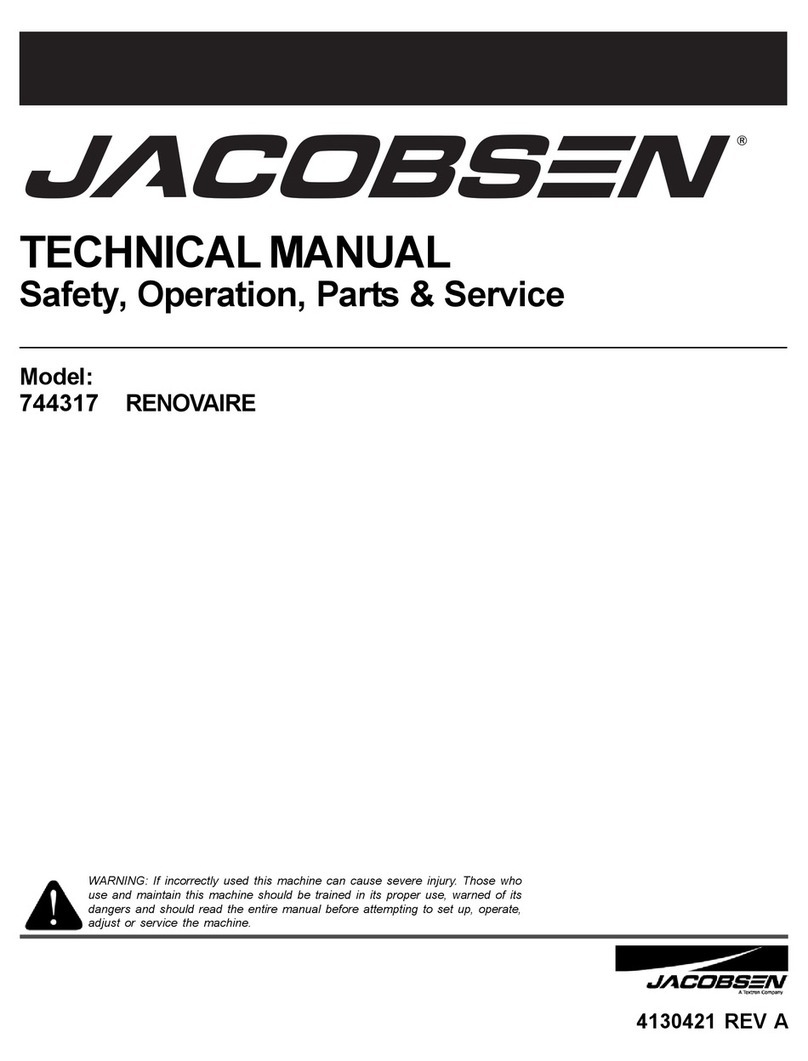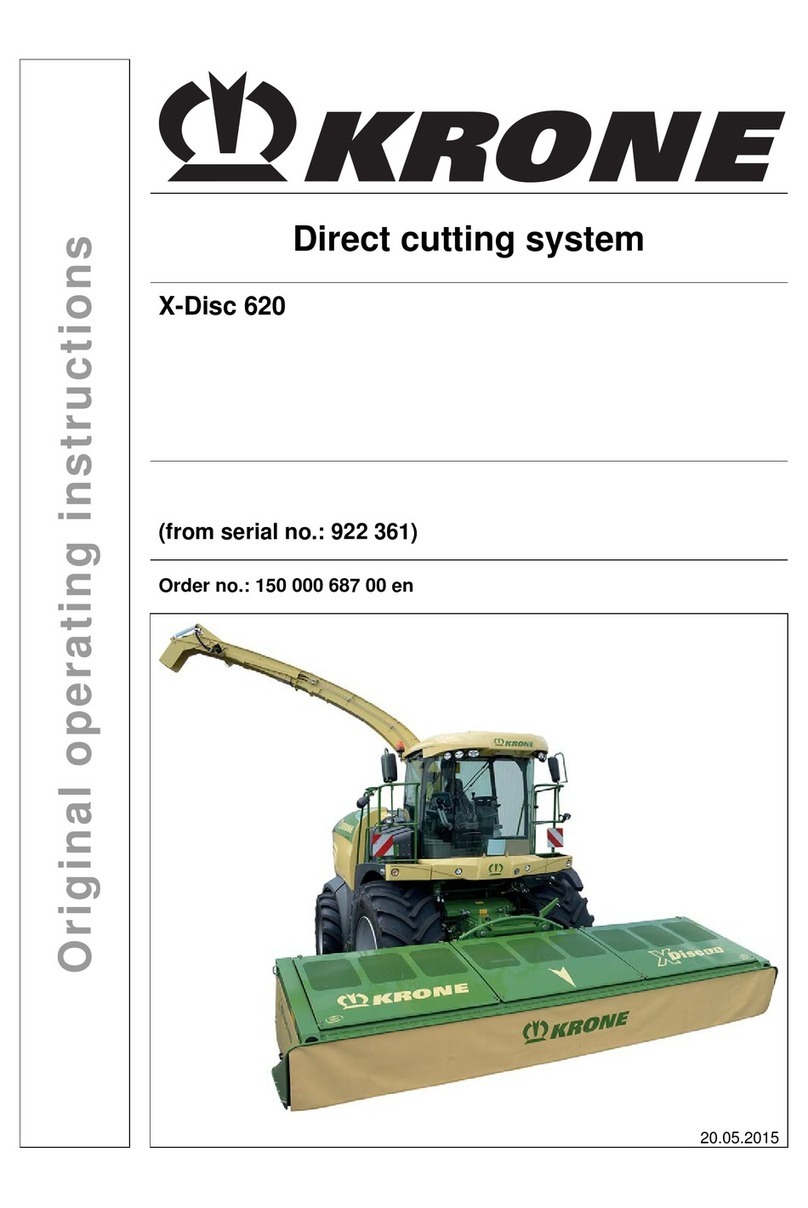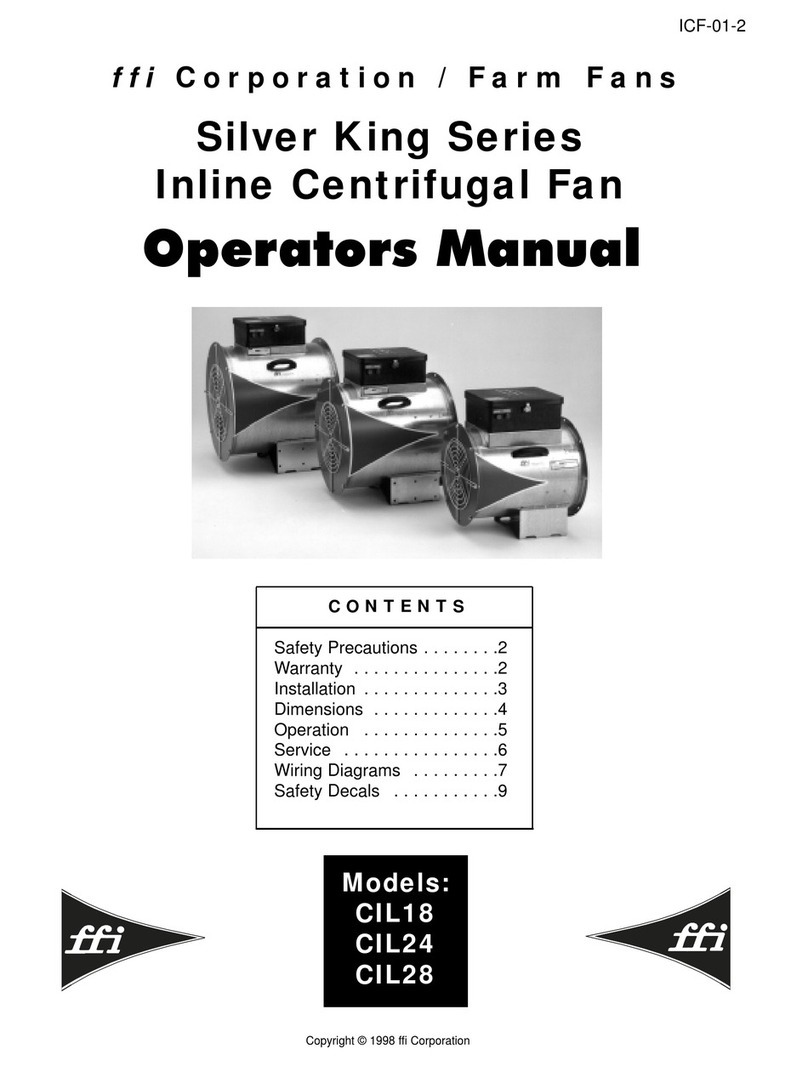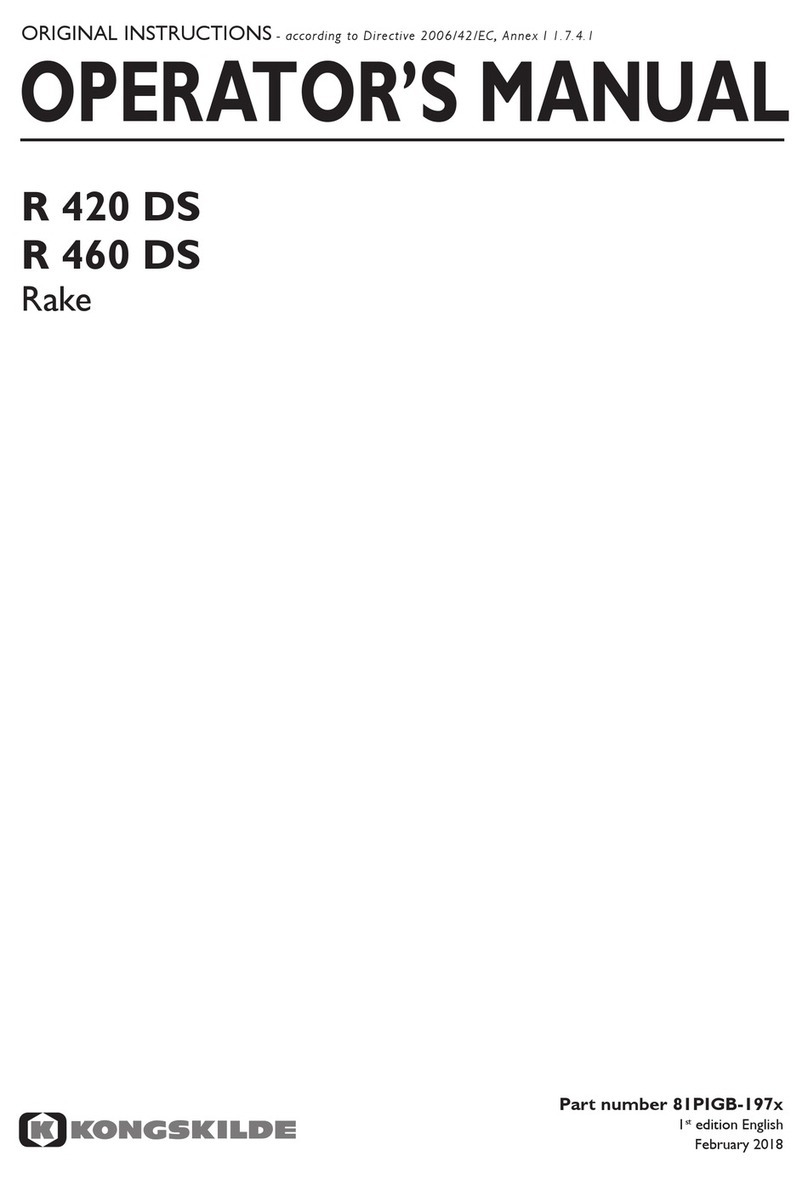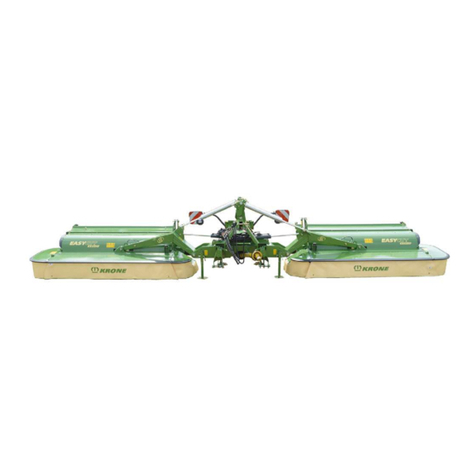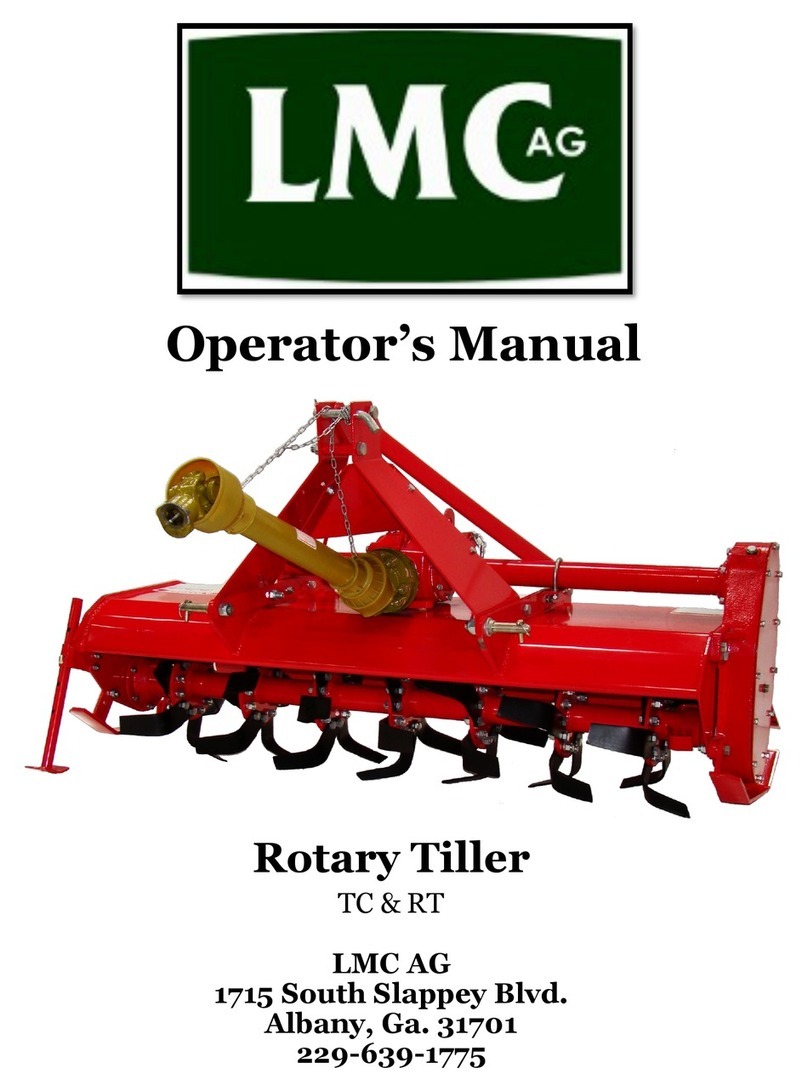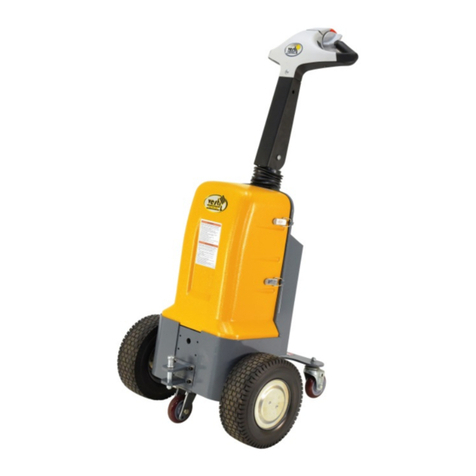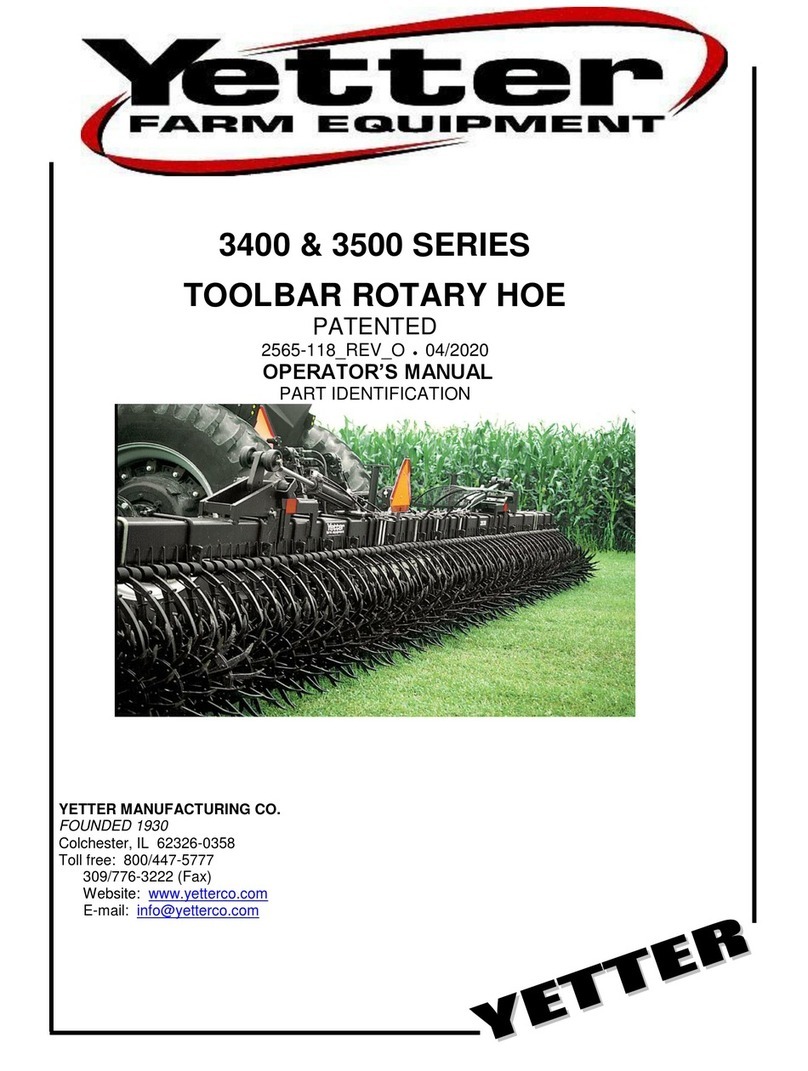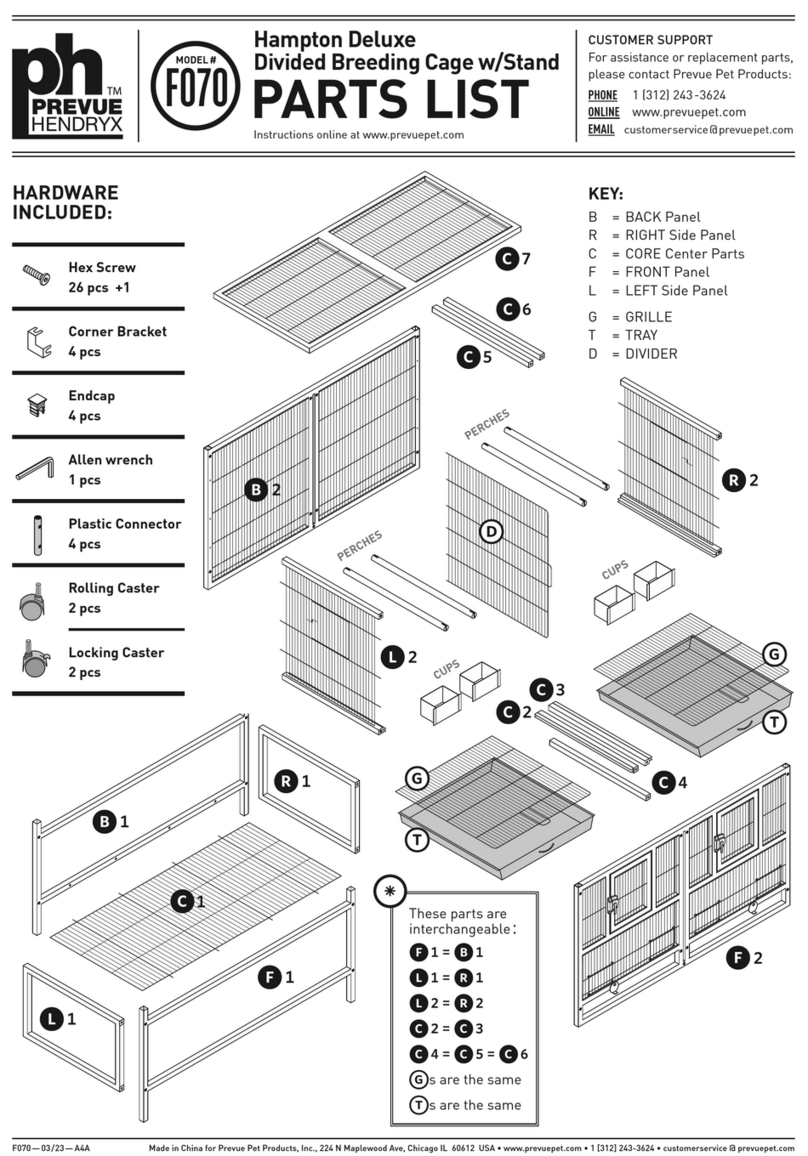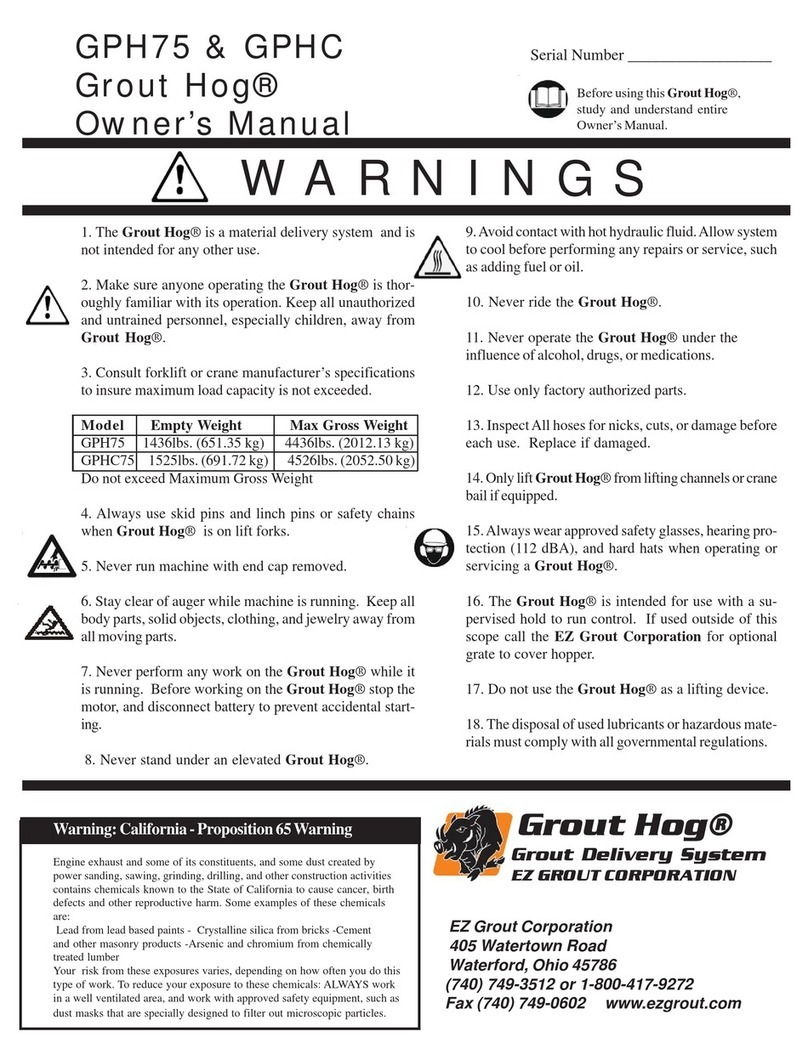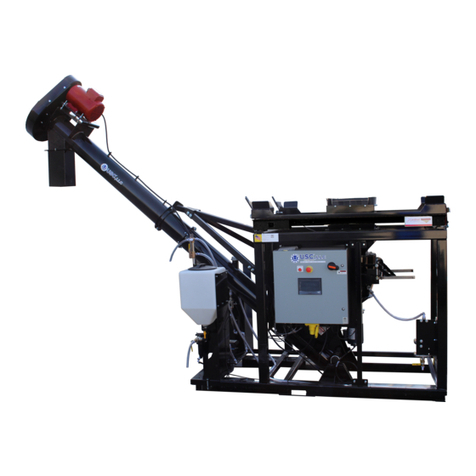Textron SODCUTTER 544847B User manual

HEAVY DUTY SODCUTTER
MODELS: 544847B, 544853B, 544854B
TECHNICAL MANUAL
Part No. 524546 Rev. 1
(Safety,Operation, Parts and Service)
GB E

1 GENERAL INFORMATION
250–6–00–CU
2000 Textron Inc.
Lincoln, Nebraska •All Rights Reserved.
Printed in U.S.A.
1.1 GENERAL INFORMATION
IMPORTANT!
THIS MANUAL WILL AID YOU IN THE SAFE
OPERATION AND PROPER MAINTENANCE OF
YOUR EQUIPMENT. READ MANUAL THOROUGHLY
BEFORE ATTEMPTING OPERATION. IF ANY
PORTION IS NOT CLEARLY UNDERSTOOD,
CONTACT AN AUTHORIZED DEALER FOR
CLARIFICATION.
To make sure you are fully aware of safety and service
information, the following two symbols are used
throughout this manual.
!This symbol is used throughout the manual to
alert you to information about unsafe actions or
situations, and will be followed by the word DANGER,
WARNING, or CAUTION. DANGER indicates
immediate hazards that may result in severe injury or
death. WARNING indicates unsafe actions or situations
that may cause severe injury, death and/or major
equipment or property damage. CAUTION indicates
unsafe actions or situations that may cause injury, and/or
minor equipment or property damage.
NOTE:
This appears next to information or instructions
which will help you operate and maintain your
equipment the right way.
WARNING
The information and instructions included in
this manual alert you to certain things you
should do very carefully. If you do not, you
could:
•hurt yourself or others
•hurt the next person who operates the
equipment
•damage the equipment.
This manual contains essential operation and
safety information and must remain with the
unit at all times, within easy access of any op-
erator.
!
Additional manuals are available through your dealer.
IMPORTANT!
THIS EQUIPMENT SHOULD NOT BE MODIFIED OR
ADDED TO WITHOUT THE MANUFACTURER’S
AUTHORIZATION.
WARNING
Altering this equipment in any manner which
adversely affects the equipments operation,
performance, durability or use, may cause haz-
ardous conditions.
!
Direct any inquiries to:
Textron Turf Care and Specialty Products
Attn: Director of Engineering Services
P.O. Box 82409
Lincoln, NE 68501–2409 USA
SPECIFICATION INFORMATION
All information contained in this manual is the latest
available at the time of printing. Textron Turf Care and
Specialty Products reserves the right to make changes
at any time without notice.
Whenever a name brand product is specified, an
equivalent product may be used unless stated otherwise.
CHANGE OF OWNERSHIP OR ADDRESS
Textron Turf Care and Specialty Products makes every
effort to keep owners informed of all safety related
information. Therefore, changes in ownership and/or
address should be reported to the manufacturer.
Your dealer has REGISTRATION CHANGE FORMS
which will be filled out and filed by the dealer for his
records, and a copy will be sent to the manufacturer.
DEALER INFORMATION
For your nearest dealer location write to:
Textron Turf Care and Specialty Products
Attn: Sales Coordinator
P.O. Box 82409
Lincoln, NE 68501–2409 USA
In the USA and Canada call 1–888–922–8873 (dealer
information only).

1
TABLE OF CONTENTS Page
1 General Information Inside Front Cover. . . . . . . . . . . . . . . . . . . . . . . . . . . . . . . . . . . .
2 Identification 3. . . . . . . . . . . . . . . . . . . . . . . . . . . . . . . . . . . . . . . . . . . . . . . . . . . . . . . . .
3 Specifications 4. . . . . . . . . . . . . . . . . . . . . . . . . . . . . . . . . . . . . . . . . . . . . . . . . . . . . . . .
4 Set-up 5. . . . . . . . . . . . . . . . . . . . . . . . . . . . . . . . . . . . . . . . . . . . . . . . . . . . . . . . . . . . . . .
4.1 Sep–Up 5. . . . . . . . . . . . . . . . . . . . . . . . . . . . . . . . . . . . . . . . . . . . . . . . . . . . . . . . .
4.2 Sod Cutter With Walking Ram Auto Cut-off 6. . . . . . . . . . . . . . . . . . . . . . . . . .
5 Operation And Controls 7. . . . . . . . . . . . . . . . . . . . . . . . . . . . . . . . . . . . . . . . . . . . . . . .
5.1 Operation And Controls 7. . . . . . . . . . . . . . . . . . . . . . . . . . . . . . . . . . . . . . . . . . .
5.2 Pre-operation Check 7. . . . . . . . . . . . . . . . . . . . . . . . . . . . . . . . . . . . . . . . . . . . . .
5.3 Before Starting Engine 7. . . . . . . . . . . . . . . . . . . . . . . . . . . . . . . . . . . . . . . . . . . .
5.4 Starting Engine 7. . . . . . . . . . . . . . . . . . . . . . . . . . . . . . . . . . . . . . . . . . . . . . . . . .
5.5 Moving Unit 7. . . . . . . . . . . . . . . . . . . . . . . . . . . . . . . . . . . . . . . . . . . . . . . . . . . . .
5.6 To Adjust Depth Of Cut 8. . . . . . . . . . . . . . . . . . . . . . . . . . . . . . . . . . . . . . . . . . .
5.7 To Adjust Blade Angle 9. . . . . . . . . . . . . . . . . . . . . . . . . . . . . . . . . . . . . . . . . . . .
5.8 Blade Angle (Pitch) 9. . . . . . . . . . . . . . . . . . . . . . . . . . . . . . . . . . . . . . . . . . . . . . .
5.9 Operating With Walking Ram Auto Cut-off Or
Rolling Ram Cut–off And Sulky Roller 9. . . . . . . . . . . . . . . . . . . . . . . . . . . . . . .
5.10 Cut-off Blade Penetration 9. . . . . . . . . . . . . . . . . . . . . . . . . . . . . . . . . . . . . . . . .
5.11 Sprocket And Chain Replacement For Metering Wheel 11. . . . . . . . . . . . . . .
5.12 Cut-off Theory Of Operation Pressure Plate 11. . . . . . . . . . . . . . . . . . . . . . . . .
5.13 Pressure Plate Control 12. . . . . . . . . . . . . . . . . . . . . . . . . . . . . . . . . . . . . . . . . . .
5.14 Triggering 12. . . . . . . . . . . . . . . . . . . . . . . . . . . . . . . . . . . . . . . . . . . . . . . . . . . . . .
5.15 Automatic Cut-off Adjustments 13. . . . . . . . . . . . . . . . . . . . . . . . . . . . . . . . . . . .
5.16 Shaft Nut Adjustment 13. . . . . . . . . . . . . . . . . . . . . . . . . . . . . . . . . . . . . . . . . . . .
5.17 Trigger And Trip Arm Adjustment 14. . . . . . . . . . . . . . . . . . . . . . . . . . . . . . . . . .
5.18 Checking Brake Clearance 14. . . . . . . . . . . . . . . . . . . . . . . . . . . . . . . . . . . . . . .
5.19 Disassembly Of Cut-off 14. . . . . . . . . . . . . . . . . . . . . . . . . . . . . . . . . . . . . . . . . .
5.20 Assembly Of Cut-off 16. . . . . . . . . . . . . . . . . . . . . . . . . . . . . . . . . . . . . . . . . . . . .
5.21 Spring Pressure Adjustment 16. . . . . . . . . . . . . . . . . . . . . . . . . . . . . . . . . . . . . .
5.22 Adjusting Pressure Plate Clearance 17. . . . . . . . . . . . . . . . . . . . . . . . . . . . . . .
6 Service 19. . . . . . . . . . . . . . . . . . . . . . . . . . . . . . . . . . . . . . . . . . . . . . . . . . . . . . . . . . . . .
6.1 Lubrication 19. . . . . . . . . . . . . . . . . . . . . . . . . . . . . . . . . . . . . . . . . . . . . . . . . . . . .
6.2 Belt Adjustment 19. . . . . . . . . . . . . . . . . . . . . . . . . . . . . . . . . . . . . . . . . . . . . . . . .
6.3 Belt Replacement 20. . . . . . . . . . . . . . . . . . . . . . . . . . . . . . . . . . . . . . . . . . . . . . .
6.4 Chain Replacement Drive Chain 20. . . . . . . . . . . . . . . . . . . . . . . . . . . . . . . . . .
6.5 Dog Wheel Chain Replacement 20. . . . . . . . . . . . . . . . . . . . . . . . . . . . . . . . . . .
6.6 Cut-off Drive Chain 20. . . . . . . . . . . . . . . . . . . . . . . . . . . . . . . . . . . . . . . . . . . . . .
6.7 Metering Wheel Chain 20. . . . . . . . . . . . . . . . . . . . . . . . . . . . . . . . . . . . . . . . . . .
6.8 Gear Replacement 21. . . . . . . . . . . . . . . . . . . . . . . . . . . . . . . . . . . . . . . . . . . . . .
6.9 Sliding Gear 23. . . . . . . . . . . . . . . . . . . . . . . . . . . . . . . . . . . . . . . . . . . . . . . . . . . .
6.10 Gear And Upper Chain Sprocket 23. . . . . . . . . . . . . . . . . . . . . . . . . . . . . . . . . .
6.11 Drive Wheel Chain Sprocket 23. . . . . . . . . . . . . . . . . . . . . . . . . . . . . . . . . . . . . .
6.12 Blade Sharpening 24. . . . . . . . . . . . . . . . . . . . . . . . . . . . . . . . . . . . . . . . . . . . . . .
6.13 Touch-up Paint 24. . . . . . . . . . . . . . . . . . . . . . . . . . . . . . . . . . . . . . . . . . . . . . . . .
7 Storage 25. . . . . . . . . . . . . . . . . . . . . . . . . . . . . . . . . . . . . . . . . . . . . . . . . . . . . . . . . . . . .
7.1 Storage Instructions 25. . . . . . . . . . . . . . . . . . . . . . . . . . . . . . . . . . . . . . . . . . . . .
7.2 Extended Storage 25. . . . . . . . . . . . . . . . . . . . . . . . . . . . . . . . . . . . . . . . . . . . . . .
7.3 To Put Equipment Into Operation After An Extended Storage 25. . . . . . . . . .
8 Trouble Shooting 26–27. . . . . . . . . . . . . . . . . . . . . . . . . . . . . . . . . . . . . . . . . . . . . . . . .
9 Accessories 59–63. . . . . . . . . . . . . . . . . . . . . . . . . . . . . . . . . . . . . . . . . . . . . . . . . . . . . .
10 Parts
10.1 Cut–Off Clutch 64–65. . . . . . . . . . . . . . . . . . . . . . . . . . . . . . . . . . . . . . . . . . . . . . .
10.2 Gear Case 66–69. . . . . . . . . . . . . . . . . . . . . . . . . . . . . . . . . . . . . . . . . . . . . . . . . .
10.3 Engine, Mount & Covers 70–71. . . . . . . . . . . . . . . . . . . . . . . . . . . . . . . . . . . . . .
10.4 Control Handles, Pitman & Side Arms 72–73. . . . . . . . . . . . . . . . . . . . . . . . . . .
10.5 Blade, Mounts, Rocker Arms & Ram 74–75. . . . . . . . . . . . . . . . . . . . . . . . . . . .
10.6 Cut–Off Case, Metering Wheel 76–79. . . . . . . . . . . . . . . . . . . . . . . . . . . . . . . . .
10.7 Handlebars 80–81. . . . . . . . . . . . . . . . . . . . . . . . . . . . . . . . . . . . . . . . . . . . . . . . . .
10.8 Rear Wheels 82–83. . . . . . . . . . . . . . . . . . . . . . . . . . . . . . . . . . . . . . . . . . . . . . . .
10.9 Decals 84–85. . . . . . . . . . . . . . . . . . . . . . . . . . . . . . . . . . . . . . . . . . . . . . . . . . . . . .

2
M4 M5 M6 M7 M8 M10 M12 M14 M16 M18 M20 M22 M24 M27
ft. lbs. 1.5 3 5.2 8.2 13.5 24 43.5 70.5 108 142 195 276 353 530
N·m 2 4 7 11 18 32 58 94 144 190 260 368 470 707
ft. lbs. 2.2 4.5 7.5 12 18.8 35.2 62.2 100 147 202 275 390 498 747
N·m. 3 6 10 16 25 47 83 133 196 269 366 520 664 996
ft. lbs. 2.7 5.2 8.2 15 21.8 43.5 75 119 176 242 330 471 596 904
N·m 3.6 7 11 20 29 58 100 159 235 323 440 628 794 1205
1/4 5/16 3/8 7/16 1/2 9/16 5/8 3/4 7/8 1 1 1/8
ft. lbs. 9 18 31 50 75 110 150 250 378 583 782
N·m 12 24 42 68 102 150 203 339 513 790 1060
ft. lbs. 13 28 46 75 115 165 225 370 591 893 1410
N·m 18 38 62 108 156 224 305 502 801 1211 1912
ft. lbs. 24 40
N·m 33 54
TORQUE SPECIFICATIONS
HEX HEAD CAP SCREWS
* Grade 5 marking – Minimum commercial quality (Lower quality not recommended).
U.S. Standard Hardware
Grade Shank Size (Diameter in inches, fine or coarse thread)
SAE
grade
5 *
SAE
grade
8 **
Flangelock
Screw w/
Flangelock
Nut
The torque values shown should be used as a general guideline when specific torque values are not given.
** Grade 8 marking –
Grade Shank Size (Diameter in millimeters, fine or coarse thread)
Grade
8.8*
Grade
10.9**
Grade
12.9 ***
Metric Standard Hardware
* Grade 8.8 marking – ** Grade 10.9 marking – *** Grade 12.9 marking –
8.8 10.9 12.9

IDENTIFICATION 2
3
2.1 IDENTIFICATION
Model No. 544847B
Heavy Duty Sod Cutter, 12” (305 mm)
w/cut-off
Model No. 544853B
Heavy Duty Sod Cutter, 16” (406 mm)
w/cut-off
Model No. 544854B
Heavy Duty Sod Cutter, 18” (457 mm)
w/cut-off
1
5027
FIGURE 1
1. Model and Serial Number Plate
The RYAN Heavy–Duty Sodcutter model and serial num-
bers are both located on the identification nameplate
decal shown in Figure 1.
NOTE:
These identification numbers must appear on all
correspondence concerning this unit.

3.1 SPECIFICATIONS
4
3.1 SPECIFICATIONS
Axles Drive wheel; splined 1 3/4”. . . . . . . . . . . . . . . (44.5 mm) diameter mounted
in ball bearings.
Rear; center pivot rocking.
Blades High carbon steel.. . . . . . . . . . . . . Hardened and sharpened.
Blades, oscillating 1,135 oscillations/min. at. . 2600 engine rpm.
Chassis One-piece cast iron gear case.. . . . . . . . . . . .
Clutch Belt tightener type.. . . . . . . . . . . . . .
Cut-off drive #50 roller chain from gear case.. . . . . . . .
Cut-off length Adjustable from 1 ft. to 9 ft.. . . . . (305 mm to 2.7M)
Cutting speed Ft./min. (Meters/min.). . . . . . . Low gear High gear
150’ (45.7 m) 188’ (57.3 m)
Theoretical at 2600 rpm.
Cutting thickness Precisely adjustable to 2 1/2”. . . (63.5 mm)
Drive Two banded A-section belts. . . . . . . . . . . . . . . from engine to gear case.
Ten-pitch gears and #50 roller
chain running in oil, in gear
case
to drive wheels.
Seven-pitch gears to eccentric
shaft to oscillating blade.
Engine Kohler 11 h.p. with rewind. . . . . . . . . . . . . starter. Model CH 11T, Specifi–
cation No. PS–1619.
Governor set at 3200 r.p.m.
at no load. Engine displace–
ment is 24.3 cu. in. (398 cc) and
develops 20.2 ft.–lbs. (27.4
N⋅m) of torque at 2000 r.p.m.
Lubrication Oil splash in gear case,. . . . . . . . . pressure lubrication fittings
elsewhere.
Reduction Engine to blade; 2.29:1. . . . . . . . . .
Engine to drive wheels;
High; 29.1:1, Low; 36.2:1
Engine to auto cut-off; 4.82:1
Rolling racks Adjustable to various sod. . . . . . . lengths, 6 ft. (1,829 mm) to
9 ft. (2,743 mm)
Transmission Sealed case. Two forward. . . . . . . speeds and neutral. Dog
clutch to disengage blade.
All gears heat-treated steel.
Weight 544847 -12” 481 lbs. (218 kg.). . . . . . . . . . . . . 544853 - 16” 522 lbs. (237 kg.)
544854 - 18” 551 lbs. (250 kg.)
Wheel Base 22 3/4” (578 mm) without Sulky. . . . . . . . . 60 3/4” (1,238 mm) with Sulky

SET–UP 4
5
4.1 SET-UP
CAUTION
!
To prevent possible injury to yourself or
bystanders, stand clear when cutting banding.
Banding is under tension and can snap back
when cut.
DO NOT operate this equipment until you have
thoroughly read and completely understand
the controls and operating sections of this
manual. If any part of this manual is not under-
stood, contact an authorized RYAN dealer for
clarification.
To prevent injury, use an adequate lifting
device (i.e., hoist, fork lift, etc.) to remove unit
from pallet.
1. Remove and discard banding securing sod cutter to
pallet.
2. Remove and discard tape securing handle and
clutch control. Remove these parts from unit.
3. Remove sod cutter from pallet using an adequate lift-
ing device.
4. Remove the two screws and lockwashers from
upper rear of gear case and install upper portion of
handle using the hardware previously removed.
Secure the lower end of the handle using one (1)
1/2-13 x 2” screw, lockwasher and nut. See Figure 1.
1
21
5031
FIGURE 1
1. Hardware
2. Handle
5. Attach clutch control lever to left side of handle
assembly using two (2) 1/4-20 x 5/8” cap screws and
locknuts. See Figure 2. Connect the two control links
(Part Nos. 520689 and 521796) together and secure
using two (2) 5/16-18 x 1” flangelock screws and flan-
gelock nuts.
NOTE:
The 5/16-18 and the 5/16-24 flangelock nuts are
included in the loose parts bag. BE SURE to use the
correct nut for the proper application.
5034
1
2
FIGURE 2
1. Clutch Control Lever
2. Throttle Control
6. Locate throttle cable, convoluted tubing and wire
from operator presence control on handle assembly.
Route the convoluted tubing along the handle and
attach to handle with wire tie. Route tubing through
clamp on side of gear case.
7. Connect wire from operator presence control to
engine at location (engine control plate) shown in
Figure 3.
5035
1
FIGURE 3
1. Operator Presence Wire

4 SET–UP
6
8. Attach throttle cable to carburetor and secure with
existing clamp. Secure convoluted tubing to handle
using wire tie from loose parts bag.
9. Attach the cutting blade to the side arms. Secure
using six (6) 5/16-24 x 1” screws and flangelock nuts.
See Figure 4. Torque to 25 ft.-lbs. (34 N·m).
NOTE:
If sod hold-downs are being used, install them at
this time. Refer to the installation instructions
included with the sod hold-down accessory Part No.
545637.
4607
1
2
2
FIGURE 4
1. Cutting Blade
2. Side Arm
4.2 SOD CUTTER WITH WALKING
RAM AUTO CUT-OFF
After the Sod Cutter has been assembled, as described
in Steps 1 - 7 in the Set-Up Instructions, continue with the
following instructions:
1. Attach metering wheel control lever to right side of
handle. Secure to handle using two (2) 1/4-20 x 5/8”
cap screws and locknuts. See Figure 5. Attach
adjuster links (Part Nos. 521804 and 518245) to
metering wheel.
1
5034
FIGURE 5
1. Metering Wheel Control Lever
2. Attach the blade mount to cut-off blade using one (1)
3/8-16 x 1 1/8” screw, lockwasher and nut on each
end (for units with 16” and 18” blades). For units with
12” blade go to Step 3. Bevel on cut-off blade must
face the rear. See Figure 6.
1
2
FRONT
OF
UNIT
FIGURE 6
1. Blade Mount
2. Cutting Blade
3. Install cut-off blade w/mount, to cut-off ram using four
(4) 3/8-16 x 1 1/8” screws, lockwashers and nuts.
Torque to 40 ft.-lbs, (54 N·m).

OPERATION & CONTROLS 5
7
5.1 OPERATION AND CONTROLS
WARNING
!
NEVER disable the operator presence control
by altering or modifying it in any way.
NEVER start or run the engine inside where
exhaust fumes can collect. Carbon monoxide
present in the exhaust is an odorless and
deadly gas. Provide adequate ventilation.
To prevent possible injury, DO NOT operate
equipment without all shields in place. NEVER
make adjustments or perform maintenance on
the Sodcutter while engine is running.
Gasoline is extremely flammable and highly
explosive under certain conditions. ALWAYS
stop engine and DO NOT smoke or allow open
flames or sparks when refueling.
Any warning decal that becomes illegible
MUST be replaced immediately.
DO NOT place hands or feet beneath unit at any
time.
DO NOT turn sodcutter around without raising
metering wheel (cut-off continues to operate
with metering wheel on the ground).
If malfunction occurs, cease operation
immediately. DO NOT operate equipment until
condition has been corrected.
5.2 PRE-OPERATION CHECK
Visually inspect all moving parts and fasteners, if broken
or loose, tighten and/or replace as necessary.
5.3 BEFORE STARTING ENGINE
Check engine crankcase oil level and fill if necessary.
Follow the recommendations of the engine manufacturer
for the correct type and amount of oil. Fill the fuel tank.
Check gear case for proper level of gear lube. Refer to
Lubrication section.
5.4 STARTING ENGINE
1. Place all controls in “Neutral” position.
2. Place throttle lever at half speed.
3. Place on/off toggle switch to “ON” position.
4. Pull recoil starter and choke as required. If the engine
is cold the choke should be in “ON position. If the
engine is warm, the choke should be in the “OFF”
position. After starting a cold engine, allow engine to
warm up before operating equipment.
5032
1
FIGURE 7
1. Recoil Starter
5.5 MOVING UNIT
1. To move unit without running engine, the drive shifter
handle should be located in “N” (neutral position).
See Figure 10.
2. To move unit without running the blade, place the
blade shifter handle in the “Disengaged” position
and make sure cutting blade is in the raised position.
See Figures 8A and 8B.
3. Place drive shifter handle in either “H” (high) or “L”
(low) speed range position and adjust throttle
accordingly. See Figure 9. Position unit at the begin-
ning of area to be cut.

5 OPERATION & CONTROLS
8
5030 5036
FIGURE 8A FIGURE 8B
1. Blade Shifter Handle 2. Blade Shifter Handle
(Disengaged) (Engaged)
15028
FIGURE 9
1. Drive Shifter Lever
5.6 TO ADJUST DEPTH OF CUT
1. Loosen depth stop lever and adjust depth gauge to
desired setting. Loosen depth control lever and
lower depth control until it rests on depth gauge.
Tighten depth stop and depth control levers. See Fig-
ure 10.
1
2
3
5033
FIGURE 10
1. Depth Stop Lever
2. Depth Gauge
3. Depth Control Lever
NOTE:
Numbers on depth gauge DO NOT necessarily
represent the thickness of sod being cut.
2. Engage drive shifter handle.
3. Engage blade shifter handle.
4. Lower blade to preset depth. From operators posi-
tion, lift unit’s handle with left hand, raising rear of unit
off the ground, and lower blade to preset depth with
right hand. Tighten all levers.
5. Adjust throttle to full speed.
6. Push clutch lever forward and lower handle.
7. After cutting a short distance, stop and check thick-
ness of sod. Adjust if necessary.

OPERATION & CONTROLS 5
9
5.7 TO ADJUST BLADE ANGLE
Loosen pitch control lever and move H-frame forward or
backward until blade is at desired angle of pitch. Tighten
pitch control lever. See Figure 11.
1
5029
FIGURE 11
1. Pitch Control Lever
5.8 BLADE ANGLE (PITCH)
NOTE:
Under normal conditions, blade angle is small
(blade bottom is flat). In extremely hard soil or when
cutting with a dull blade, the blade may tend to ride
out of the ground. Angling the blade down may help
solve this problem. A short trial run will indicate what
is the best blade angle for your particular situation.
Refer to Figure 12
DRIVE
WHEEL
SIDE
ARM
BLADE
ANGLE
(Pitch)
BLADE
BOTTOM
FIGURE 12
Blade Angle (Pitch)
1. At end of each cutting pass, lift handle to clear cutting
blade from sod, slow down throttle and turn sodcutter
around for return pass. When using metering wheel,
raise metering wheel before turning sodcutter.
CAUTION
!
DO NOT turn sod cutter around without first
raising the metering wheel. The cut-off will con-
tinue to operate as long as the metering wheel
is on the ground.
5.9 OPERATING WITH WALKING RAM
AUTO CUT-OFF OR
ROLLING RAM CUT–OFF
AND SULKY ROLLER
NOTE:
If the Sulky Roller Accessory (Part No. 545505)
is to be used, the sodcutter must be converted from
the auto walking ram cut-off, to rolling ram cut-off.
Use Rolling Ram Accessory (Part No. 545395) for
this conversion. Refer to accessories page.
Sodcutters equipped with auto cut-off from factory
are preset to cut sod in approximately 6’ (1,829 mm)
lengths.
Cut-off unit will not operate properly at slow engine
speeds. Maximum RPM is 2900 at no load.
Two adjustments have to be made to the cut-off unit prior
to use; cut-off blade penetration and metering wheel
adjustment.
WARNING
DO NOT place hands or feet beneath unit at any
time.
DO NOT make adjustments with engine run-
ning.
!
5.10 CUT-OFF BLADE PENETRATION
1. After setting depth gauge for desired thickness of
sod, loosen rear wheels so they can be moved up
and down. Adjust wheels so the cut-off blade will
completely separate the sod without taking more of
a cutting stroke than needed. See Figure 13.

5 OPERATION & CONTROLS
10
2182
FIGURE 13
1. Rear Wheel Adjustment
2. Run sodcutter through a couple of cut-off cycles and
determine if the thickness is correct and the cut-off
blade is cutting correctly.
NOTE:
A slight jumping of the handle is evident at each
cut, but excessive jumping indicates the cut-off
blade is entering the turf too far. Lower rear wheels
to correct jumping.
If sod is not being cut completely, raise rear wheels
slightly to lower cut-off blade.
When cut-off blade is correctly adjusted, the sod will
roll up slightly at each cutting stroke and there will be
a slight penetration into the soil below the sod with-
out excessive jumping of the handle.
METERING WHEEL ADJUSTMENT
SPROCKET AND CHAIN NUMBER
LENGTH
OF
CUT
516384
12T SPROCKET ∗516386
18T SPROCKET
547026 CHAIN
100 LINKS W/CON 103 links w/con
1’ - 0” (305 mm)
1’ - 6” (457 mm)
2’ - 0” (610 mm)
2’ - 6” (762 mm)
3’ - 0” (914 mm)
4’ - 6”
(1,372 mm)
∇6’ - 0”
(1,829 mm)
6’ - 9”
(2,057 mm)
9’ - 0”
(2,743 mm) 1
1
1
1 - 5
1 - 5
1 - 4 - 6
1 - 4 - 6
1 - 3 - 5 - 7
1 - 3 - 5 - 7
1 - 2 - 4 - 5 - 6 - 8
1 - 2 - 4 - 5 - 6 - 8
Number and Position
of
Dog(s) on Dog Wheel
Discontinued
1992 & Prior∗
Obtain No. 35 chain
locally
∇6’ - 0” (1,829 mm) - Factory Setting
1. Use the previous Dog Arrangement Chart to deter-
mine appropriate position for specific sod lengths.
2. Select desired length of cut.
3. Read top of column to determine correct sprocket
and chain required for that cut.
4. Read across to determine number of dog(s) required
and their position on the dog wheel. See Figure 14.
12
3
4
5
6
7
8
FIGURE 14
1. Dog Wheel (showing dog locations)
5. With first adjustments completed and engine run-
ning, position sodcutter at start of cut.

OPERATION & CONTROLS 5
11
6. Unlock rear wheels (if locked) by turning the locks
counterclockwise.
7. Lower metering wheel to ground and engage drive
shifter lever.
8. Lift handle of unit, raising rear of unit off ground, and
lower blade to preset depth. If the Sulky Roller
Accessory is to be used, attach to sodcutter with
hitch pin at this time. See Sulky Roller parts pages.
9. Adjust throttle to full speed.
10. Operate unit until several cuts have been made.
11. Check for correct sod lengths. If fine adjustments
need to be made, adjust the segments (Part No.
515534) on the metering wheel. Segments can be
moved out to increase cut length, or moved in to
decrease the length of cut. Be certain all segments
are adjusted uniformly.
NOTE:
Adjustments of up to 2” (50.8 mm) per ft. can be
made by adjusting the segments.
12. At the end of each pass it will be necessary to discon-
nect the Sulky Roller while turning the unit around to
begin the next pass.
5.11 SPROCKET AND CHAIN
REPLACEMENT FOR
METERING WHEEL
1. Remove metering wheel for easier access to screws
in chain guard. Refer to Figure 15.
2. Remove chain guard and chain.
3. Remove upper sprocket from shaft. DONOT
remove
washer from behind sprocket.
CHAIN
CHAIN GUARD
COVER
WASHER
SPROCKET
METERING WHEEL
SEGMENT
INCREASE
DECREASE
FIGURE 15
4. Install new sprocket and attach to shaft. Be sure key
and key-way are aligned so the key will not be
pushed out of the shaft. Install new chain.
5. Install chain on lower sprocket and install chain
cover and metering wheel.
5.12 CUT-OFF THEORY OF OPERATION
PRESSURE PLATE
(A) The Cut-off Unit is a single revolution, self-contained,
friction clutch and brake unit.
(B) A spring loaded pressure plate, with a horizontal
movement of approximately .005”, is controlled to apply
pressure on one of the friction discs on each side of the
plate.
(C) When the plate is pulled back (spring compressed)
the braking friction disc makes contact with the stationary
housing which stops the rotary movement of the plate.
(D) When the plate is released (spring expanded) the
clutch friction disc comes into contact with the revolving
flywheel and rotates the plate through a single revolution
cycle before the plate is again pulled into its braking posi-
tion.
(E) As the pressure plate rotates through its single cycle,
the connecting rod drives the cut-off blade in and out of
the ground.

5 OPERATION & CONTROLS
12
CLUTCH
LINER
FIGURE 16
Cut Away View Of Automatic Cut-Off
SHIMS
WASHER
LOCKING
SCREW
END BOLT
TIE ROD CAM
YOKE
SPRING
HOUSING
FLYWHEEL
TRUNNION
ROLLER
SET
SCREW
PLUG
SHAFT NUT
(ADJUSTING NUT)
BRAKE
LINING
PRESSURE
PLATE
HOUSING
ECCENTRIC
SHAFT
ROLLER
SHAFT
NUT
SPRING
CLUTCH
FRICTION DISC
FLYWHEEL PRESSURE
PLATE
BRAKE
FRICTION
DISC
SPRING
SHAFT
CAM
APPROX.
.005”
Figure 17
Pressure Plate Operation
5.13 PRESSURE PLATE CONTROL
(A) The control of the pressure plate is accomplished
through the spring in the center of the clutch shaft and
two rollers mounted on the cam end.
(B) The rollers ride on an incline on the cam end, and
when on the rise on the incline, pull the spring shaft
(attached to the pressure plate) back against the spring
into the braking position.
(C) When the rollers are on the low spot of the incline, the
spring forces the pressure plate against the flywheel.
5.14 TRIGGERING
(A) The triggering of the rotation cycle is accomplished
through a dog wheel which is mounted on the right side of
the clutch unit.
(B) The dog wheel, which is chain driven by the metering
wheel, trips the trigger which has locked the cam into the
braking position. See Figure 18.
DOGWHEEL
CAM
TRIGGER
TRIP ARM
Figure 18
Trigger and Trip Arm

OPERATION & CONTROLS 5
13
(C) A cycle begins with the trigger locking the cam, which
places the rollers on the rise of the cam incline. (This has
pulled the pressure plate into its braking position against
the housing, and holds the connecting rod at the top of its
stroke, which holds the cutting blade in the up position).
(D) The metering wheel rotation, turns the dog wheel
which lifts the trigger and releases the cam.
(E) The cam rotates and the rollers run down the incline
allowing the spring to force the pressure plate against the
flywheel.
(F) The flywheel rotates the pressure plate and eccentric
shaft, to which the connecting rod is attached.
(G) The down stroke of the connecting rod (attached to
the cutting blade) produces the cutting stroke of the
blade.
(H) At the end of one revolution, the trigger slides into the
notch of the cam locking it into position. The rollers are
forced up the cam end incline, pulling the pressure plate
into its braking position and locking the cutting blade in
the up position.
5.15 AUTOMATIC CUT-OFF
ADJUSTMENTS
If the cut-off is not operating properly, refer to the Trouble
Shooting Guide and determine what problem is occur-
ring. Use the following adjustments, as necessary, to cor-
rect the problem.
WARNING
When tripping the cut-off manually with the
metering wheel, BE SURE to keep hands and
feet away from all moving parts.
There may be tension on the cam stop and trig-
ger. Slightly rock the cut-off flywheel to release
the tension so the trigger can be lifted out of the
way.
!
5.16 SHAFT NUT ADJUSTMENT
1. Be sure trunnion rollers are in the lowest position on
the cam. This can be achieved by manually tripping
the cut-off, by rotating the metering wheel by hand.
2. Remove set screws and brass plugs in the adjusting
nut. Refer to Figure 19.
1
2
2190
FIGURE 19
1. Cam Stop
2. Set Screw(s) In Adjusting Nut
3. Lift the trigger so it does not interfere with the rocking
movement of the cam. Adjust the nut enough to allow
the cam to be rocked back and forth approximately
1/4” (6.4 mm). Using a tape measure (or ruler) verify
the 1/4” movement illustrated in Figure 20. Be sure
trigger does not interfere with cam stop.
4. Replace brass plugs, and tighten set screws. Run
through a few cycles and recheck 1/4” (6.4 mm)
measurement. It may be necessary to loosen the set
screws and readjust before final tightening.
1/4”
MOVEMENT
CAM
FIGURE 20
5. Run sodcutter through a few cycles again and check
for proper operation. Since the same problem or
occurrence can be attributed to the shaft nut as well
as the trigger, it is possible that an adjustment to the
trigger may be needed.
6. When proper adjustment of the shaft nut has been
completed and the problem still exists, continue with
the following trigger adjustment.

5 OPERATION & CONTROLS
14
5.17 TRIGGER AND TRIP ARM
ADJUSTMENT
1. Remove access cover on dog wheel assembly, and
open access cover on cut-off unit.
2. If necessary, center trigger (side to side) on cam stop
by adding .015” (.381 mm) shims (Part No. 516237)
onto trigger shaft, between the case and trigger.
Loosen set screw, and slide trigger off the shaft to
allow installation of shims.
3. Trigger must ride squarely on cam surface when
striking cam stop. If it does not, correct by loosening
the set screw on trigger and press down on trigger
until it rests on the cam. Check spring for proper ten-
sion.
NOTE:
f the cam stop surface is not square, cam stop
and trigger MUST be replaced.
4. With trigger against cam stop, the cam follower on
trip arm should just touch the dog wheel.
5. When all adjustments are made, re–tighten locking
screw on trigger (See Figure 21) and run clutch
through a few cycles. Determine if the clutch and
brake system is working correctly, if not, additional
adjustment will be required.
TRIP ARM
SPACER(S)
DOG TRIP
CAM STOP
TRIGGER TRIGGER
ADJUSTING
SCREW
FIGURE 21
5.18 CHECKING BRAKE CLEARANCE
NOTE:
As the clutch and brake liner become worn, the
clearance between clutch liner and flywheel and
brake lining and housing, will increase. If there is too
much clearance, the brake will not hold tight enough
and the rollers will run back down the slope of the
cam. The pressure plate will then move back
against the flywheel and cause excessive frictional
wear and heat.
Eventually the brake and clutch lining will need to be
replaced. If the thickness of either liner measures
less than .095” (2.4 mm) it is advisable to install new
liners.
1. Remove belt shield and cut-off blade for easier
access to clutch assembly. With pressure plate in the
locked position (ram is locked into the “UP” position)
draw a pencil mark across the housing and pressure
plate. See Figure 22.
HOUSING
PENCIL
MARK
PRESSURE
PLATE
FIGURE 22
2. With the engine running at half throttle or more (cut-
off will not operate properly at low speeds) run the
clutch through several cut-off cycles. NOTE: Manu-
ally rotating the metering wheel, will allow the dog to
trip the cut-off allowing the clutch to operate.
3. After stopping at the end of each cycle, check the
pencil mark on the pressure plate. If the mark has
slipped back 1/8” (3.2 mm) or more, the brake and
clutch clearance will have to be adjusted. Refer to the
following sections on “Disassembly and Assembly.”
5.19 DISASSEMBLY OF CUT-OFF
The following instructions will assist you in breaking
down the cut-off assembly. These instructions are used
to repair or replace a component within the cut-off
assembly.
WARNING
When tripping the cut-off manually with the
metering wheel, BE SURE to keep hands and
feet away from ALL moving parts.
!
1. With the engine stopped, manually trip the cut-off by
rotating the metering wheel. Remove the cut-off
blade and the dog wheel assembly from unit.
2. From left side of cut-off, remove belt shield and
loosen the locking screw and end bolt. Remove cut-
off drive chain and finish removing the locking screw

OPERATION & CONTROLS 5
15
and end bolt. Remove flywheel and clutch lining. See
Figure 23. If the ball bearing is worn, remove and
replace.
1
2
2538
FIGURE 23
1. Locking Screw
2. End Bolt
3. From the right side of the cut-off, remove set screws
and brass plugs from the adjusting nut. Remove the
adjusting nut, washers, yoke, cam, and thrust bear-
ing. See Figure 24.
12
3
45
2190
FIGURE 24
1. Set Screw
2. Adjusting Nut
3. Washers
4. Yoke
5. Cam
4. Remove pressure plate, brake lining, spring, and
washer.
NOTE:
If the tie rod is removed from the pressure plate,
Loctite #290 or an equivalent must be applied to
screw threads when reinstalling. Screws should be
torqued to 8 ft-lbs. (11 N·m) after reinstallation.
5. Remove springs from trigger and from cut-off ram
assembly.
6. Remove the two (2) nuts securing right side rocker
arm. Slide rocker arm out until the arm can be turned
back towards the rear of unit. See Figure 25.
1
2532
FIGURE 25
1. Nuts (Securing Rocker Arm)
7. Remove the two screws holding the retainer on the
connecting rod. Remove retainer, seal ring and con-
necting rod. See Figure 26.
12
2536
FIGURE 26
1. Retainer Screws
2. Connecting Rod
8. The eccentric is the next part on the shaft which may
be removed from unit. DO NOT remove the eccentric
unless wear is present.
9. Should the eccentric or the clutch shaft need replac-
ing, remove the snap ring from shaft (left side of unit)
and push shaft and eccentric out the right side of unit.
10. If the ball bearings in the housing are worn, it is advis-
able to replace them at this time.

5 OPERATION & CONTROLS
16
NOTE:
If the brass bushing is removed from shaft, apply
Loctite #290 or an equivalent to inside of bushing
before re–installation.
If the eccentric is removed from the shaft, Loctite
#290 or an equivalent, must be applied to the eccen-
tric surface and to the key on the shaft before re–
installation. After installation, apply more Loctite
around the key surface still showing. See Figure 27.
1
2
2537
FIGURE 27
1. Eccentric
2. Bushing
5.20 ASSEMBLY OF CUT-OFF
1. If the eccentric was removed, install from the right
side of the unit, and push shaft with eccentric, into
case and install snap ring.
2. Install the connecting rod, seal ring (concave side
toward connecting rod) and retainer. See Figure 28.
CONNECTING
ROD
CONCAVE SIDE
TO
CONNECTING ROD
1
RETAINER
FIGURE 28
1. Seal Ring
3. Install the right side rocker arm and torque nuts to
100 ft-lbs. (136 N·m). Be sure the key is in the shaft
for the rocker arm (refer to nuts shown in Figure 26).
4. Before installing the cam, remove the lubrication fit-
ting and stretch “O” ring over cam. The “O” ring will
be positioned later. See Figure 29.
1
2
3
“O” RING
ROLLED
OVER CAM
FIGURE 29
1. Thrust Washers
2. Thrust Bearing
3. Cam
5. Install thrust washers and thrust bearing into cam
and slide into place on shaft. See Figure 30.
5.21 SPRING PRESSURE ADJUSTMENT
1. From left side of cut-off, install washers and spring on
tie rod and pressure plate assembly (replace brake
lining if needed). Check the length of the spring. The
length of the spring must be 4” + .050” (102 mm + 3
mm).
NOTE:
If the spring length is not 4” + .050” (102 mm + 3
mm) the spring MUST be replaced. DO NOT add
washers or shims to make up the difference in the
length of the spring.
2. Install assembly into cut-off case housing and push
pressure plate (with tie rod) into shaft until the spring
and spacer(s) are inserted as far as possible.
3. Measure the distance from the housing flange to the
brake lining. This dimension should be 7/16” + 1/64”
(11.11 mm + .395 mm).

OPERATION & CONTROLS 5
17
4” (±.050)
SPRING
LENGTH
7/16” (+1/64”)
SPACER(S)
FIGURE 30
Spring Pressure Adjustment
4. If spring length is correct and the measurement is not
the 7/16” allowed, insert or remove the appropriate
amount of the .030” (.762 mm) spacers (Part No.
515200) to obtain the correct measurement. See
Figure 30.
5. On right side of unit, install trunnion roller assembly
onto clutch shaft by aligning the timing marks (“0”).
With the “0” on the trunnion roller facing the cam,
align the “0” on the roller with the “0” on the shaft.
Slide assembly onto the clutch shaft. See Figure 31.
NOTE:
f the “0” on the shaft is not visible, align the “0” on
the trunnion roller with the
first groove to the right
of
the keyway on the shaft.
If the timing marks (“0”) are not properly aligned, the
cut-off will not operate properly. The timing on the
cut-off revolution will not be correct and will cause
premature and/or erratic cut-off.
2
1
3
2
THE “O” ON SHAFT IS
THE FIRST GROOVE
TO THE RIGHT
OF THE KEYWAY
“O” MUST
FACE CAM
FIGURE 31
1. Trunnion Roller
2. Timing Mark
3. Clutch Shaft
6. Install the three (3) spring washers (with convex side
facing the adjusting nut) onto the shaft. See Figure 32.
1
2
FIGURE 32
1. Washers
2. Adjusting Nut
7. With set screws and brass plugs removed from
adjusting nut, install adjusting nut onto connecting
rod and tighten until pressure plate and brake lining
are tight against housing.
8. Place the “O” ring into position over the thrust bear-
ing and install the lubrication fitting.
9. On left side of cut-off, install clutch lining (replace lin-
ing if necessary), flywheel and sprocket.
5.22 ADJUSTING PRESSURE
PLATE CLEARANCE
1. Insert the locking screw partially into the end bolt,
using a lithium based lubricant, or an anti-seize com-
pound on the threads. Tighten the screw until hand
tight.
NOTE:
If locking screw is not into the end bolt far
enough, the end bolt threads will strip when shim-
ming flywheel.
2. Install end bolt (with locking screw inserted), washer
and shim pack, placing the thicker shims onto the
outside of the end bolt.
3. Tighten end bolt and torque to 75 ft-lbs. (102 N·m).
Tighten locking screw.
4. Using a feeler gauge, measure the distance between
flywheel and clutch lining to determine how many
shims to remove to obtain .005” (.127 mm) clear-
ance. See Figure 33.

5 OPERATION & CONTROLS
18
2192
FIGURE 33
Checking Clearance of .005”
NOTE:
The measurement of .005” may vary in places
around the pressure plate. Some places may read
.006” and some may read higher. As long as the nar-
rowest measurement is .005”, installation will be
correct.
5. If adjustment is necessary, loosen the lock screw in
the end bolt and remove end bolt, washer and shim
pack. See Figure 34.
12
34
FIGURE 34
1. Locking Screw
2. End Bolt
3. Washer
4. Shim(s)
6. Remove shims as required to obtain the required
.005” (.127 mm) between the clutch liner and fly-
wheel. When replacing shim pack to cut-off, place a
.015” (.381 mm) shim to the outside of the shim pack.
7. After required shim(s) is (are) removed, assemble in
reverse order of removal. Insert the locking screw
partially into the end bolt using a lithium based lubri-
cant or an anti-seize compound on the threads.
Tighten screw until hand tight. If the lock screw is not
started into the end bolt properly, the end bolt may
strip the threads when being installed
.
8. Tighten end bolt and torque to 75 ft-lbs. (101.7 N·m).
Tighten locking screw.
9. From the right side of unit, loosen the adjusting nut
until the cam can be rocked back and forth approxi-
mately 1/4” (6.4 mm). Be sure to raise the trigger to
ensure complete movement. Trigger must NOT
interfere with cam stop. See Figure 35.
BE SURE
TRIGGER DOES
NOT INTERFERE WITH
CAM MOVEMENT
FIGURE 35
1/4” (6.4 mm) Cam Movement
10. Install brass plugs and set screws into adjusting nut
and tighten set screws. Re–check the 1/4” (6.4 mm)
rocking dimension. If necessary, loosen the set
screws, readjust nut and re–tighten set screws.
11. After cam movement is adjusted properly, install the
trigger spring, cut-off ram springs, dog wheel assem-
bly and the chain guards.
12. Lubricate all fittings in the cut-off before operating
unit.
13. After assembly, refer to Page 11, “Checking Brake
Clearance” (Steps 1 thru 3) and follow instructions
accordingly.
This manual suits for next models
2
Table of contents
Languages:
Other Textron Farm Equipment manuals
Popular Farm Equipment manuals by other brands
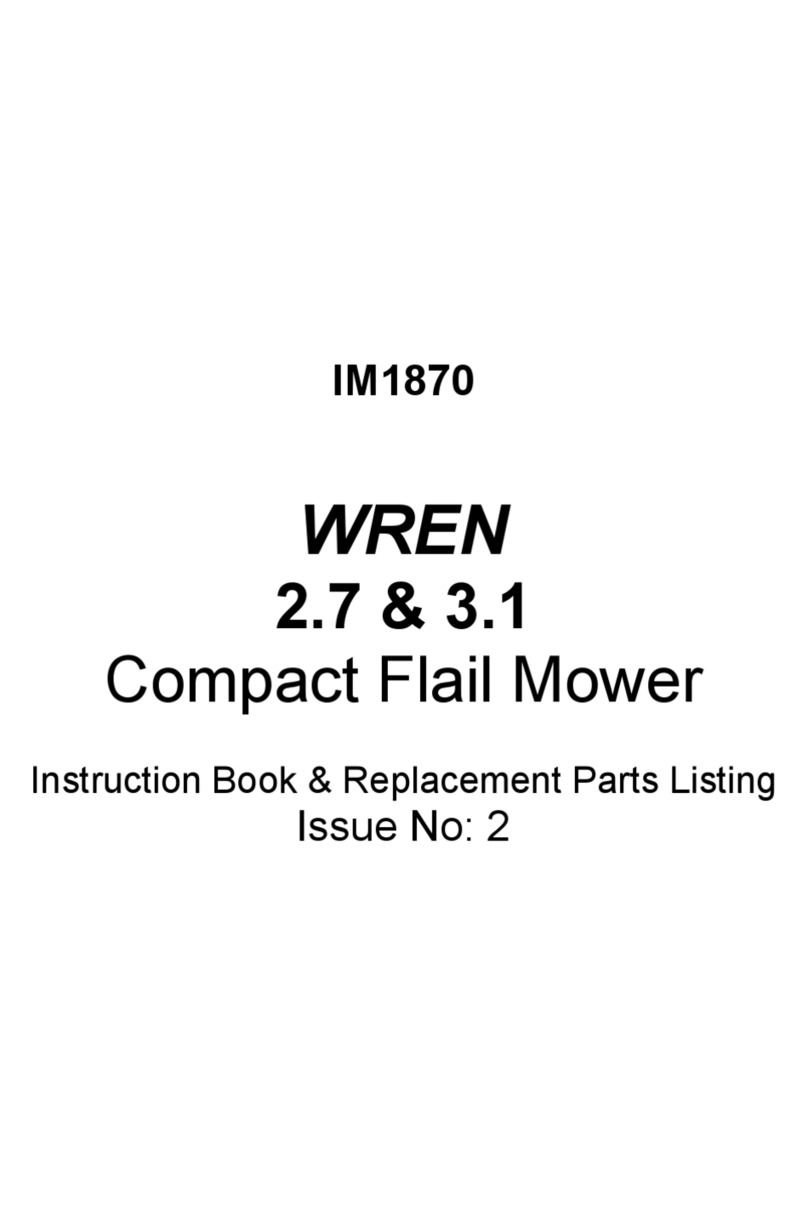
Bomford Turner
Bomford Turner WREN 2.7 Instruction Book & Replacement Parts Listing
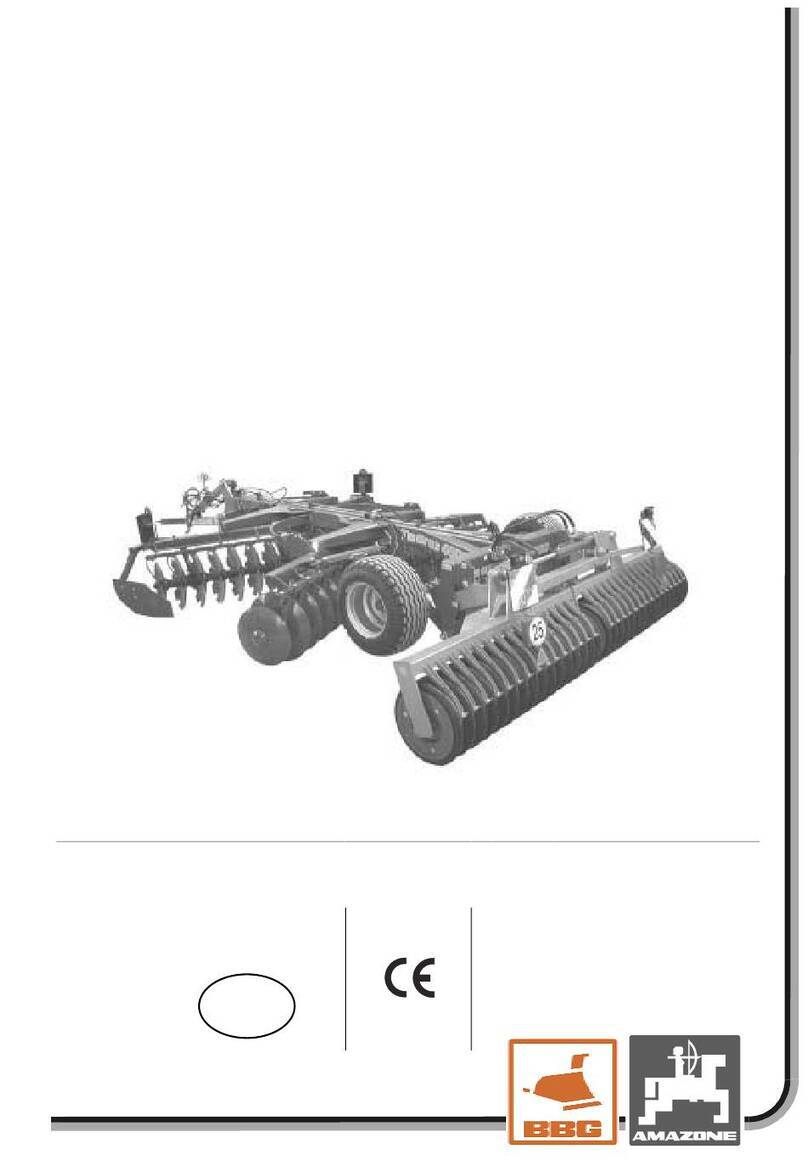
Amazone
Amazone BBG Taurus 3000 instruction manual
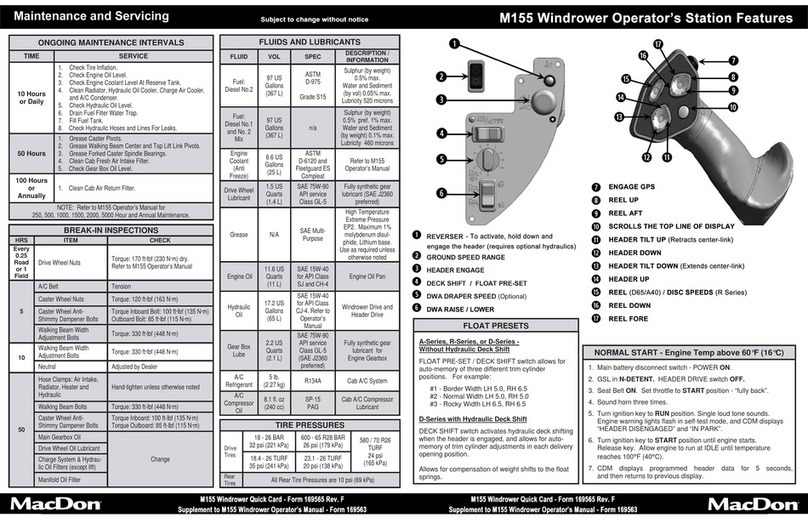
MacDon
MacDon M155 manual
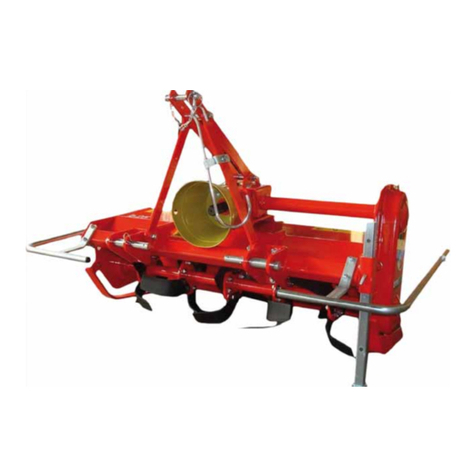
breviglieri
breviglieri b25f Series Operating and maintenance manual
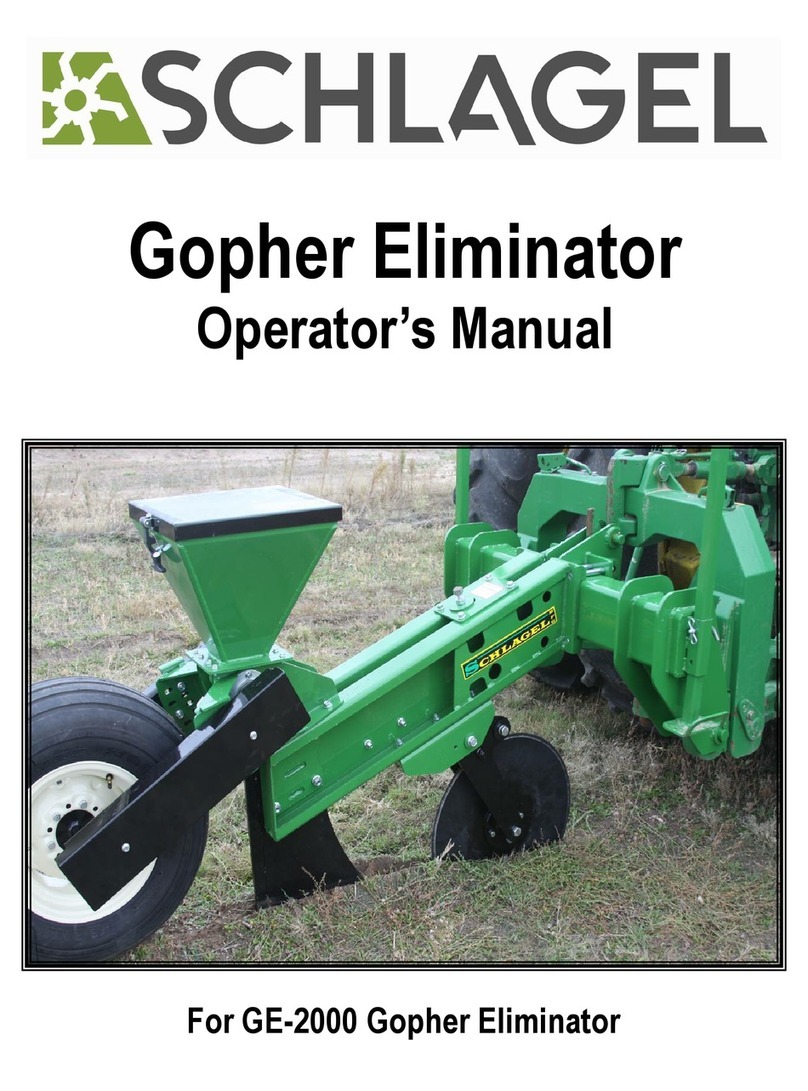
Schlagel
Schlagel Gopher Eliminator GE-2000 Operator's manual
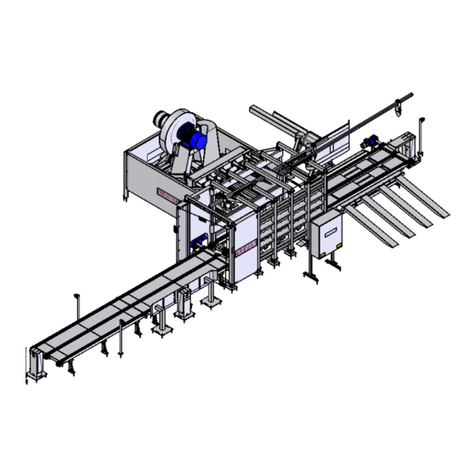
Kongskilde
Kongskilde VENTUS 2400 instruction manual

